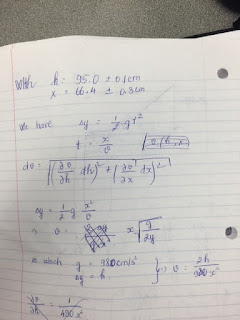Lab #7: Modeling Friction Forces
Dahlia - Ariel - Carlos
19-Sept-2016
The purpose of the lab#7 is to help students know how to calculate the static friction, kinetic friction on a level surface as well as on a sloped surface.
Part A: On a level surface
1- Static friction:
Static friction describes the friction force acting between two bodied when they are not moving relative to one another.
In this experiment, I worked with 1 block B1 with mass m stayed in table. Another mass B2 was hanging through a string and a pulley which was connecting with the block in the table.
then, I kept adding small mass onto B2 until B1 start moving. And I recorded the mass of B2.
Trail #2, I add another block on to the block B1, now I had 2 block on the table. I repeated adding small mass into B2 until 2 block on the table begin to move. and I recorded the mass of B2.
Trail #3 and trail #4, I did the same progress with 3 blocks and 4 blocks on the table.
This picture shown how I did trail #4
And this was what I recorded from 4 trials
From the free body diagram of this situation, I had Fs=hanging mass*g
N=mass of block *g
Moreover, Fs=μs*NThus, the slope of graph Fs and N was μs
based on the graph, the μs=0.532
2 - Kinetic friction
now, to find the kinetic friction, I had to give the blocks some forces.
I continued to do 4 trials with 4 different mass like part 1 above. then, I used a force sensor which was connected with log pro to read the value of force I provided for the block.
From the free body diagram of this situation, I had Fk=F-provide
N=mass of block *g
Moreover, Fk=μk*N
Thus, the slope of graph Fk and N was μk
Part A: On a level surface
1- Static friction:
Static friction describes the friction force acting between two bodied when they are not moving relative to one another.
In this experiment, I worked with 1 block B1 with mass m stayed in table. Another mass B2 was hanging through a string and a pulley which was connecting with the block in the table.
then, I kept adding small mass onto B2 until B1 start moving. And I recorded the mass of B2.
Trail #2, I add another block on to the block B1, now I had 2 block on the table. I repeated adding small mass into B2 until 2 block on the table begin to move. and I recorded the mass of B2.
Trail #3 and trail #4, I did the same progress with 3 blocks and 4 blocks on the table.
This picture shown how I did trail #4
And this was what I recorded from 4 trials
| trail # | Mass of block on table (g) | mass of hanging (g) |
| #1 | 180 | 90 |
| #2 | 320 | 180 |
| #3 | 496 | 265 |
| #4 | 629 | 330 |
From the free body diagram of this situation, I had Fs=hanging mass*g
N=mass of block *g
Moreover, Fs=μs*NThus, the slope of graph Fs and N was μs
based on the graph, the μs=0.532
2 - Kinetic friction
now, to find the kinetic friction, I had to give the blocks some forces.
I continued to do 4 trials with 4 different mass like part 1 above. then, I used a force sensor which was connected with log pro to read the value of force I provided for the block.
From the free body diagram of this situation, I had Fk=F-provide
N=mass of block *g
Moreover, Fk=μk*N
Thus, the slope of graph Fk and N was μk
This picture was when I did trial #3
Based on the graph, I could conclude the coefficient of kinetic friction was 0.26
Part B: On a sloped surface
1- Static friction:
Now, I placed a block on a horizontal surface and slowly raised one end of the surface, tilting it until the block started to slip. then, I used the angle at which slipping just began to determine the coefficient of static friction between the block and the surface.
Then, I calculated them to find the coefficient of static friction
Thus, the μs=0.4
2- Kinetic friction:
To find kinetic friction, I used a motion detector at the top of an incline steep enough that a block went down the slope
Through log pro, I got a=0.939 m/s^2
mass of the block was 0.18kg
the angle was 25.5 degrees
I used them to solve for μk
and the result was μk=0.37
Based on the graph, I could conclude the coefficient of kinetic friction was 0.26
Part B: On a sloped surface
1- Static friction:
Now, I placed a block on a horizontal surface and slowly raised one end of the surface, tilting it until the block started to slip. then, I used the angle at which slipping just began to determine the coefficient of static friction between the block and the surface.
Then, I calculated them to find the coefficient of static friction
Thus, the μs=0.4
2- Kinetic friction:
To find kinetic friction, I used a motion detector at the top of an incline steep enough that a block went down the slope
Through log pro, I got a=0.939 m/s^2
mass of the block was 0.18kg
the angle was 25.5 degrees
I used them to solve for μk
and the result was μk=0.37
























































